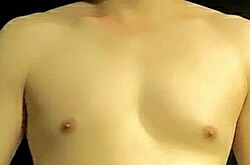Breast
The breast is an organ on the mid to upper chest area. It is just below the shoulders near the center of the upper chest region of humans and other primates. Humans have two breasts. Both boys and girls have breasts at birth. During puberty, the breasts on women grow larger and more visible. The breasts have glands that produce milk. Breastfeeding is when a mother feeds her baby with milk from her breasts.
| Breast | |
|---|---|
 | |
 Human male breasts with defined pectoral muscles | |
| Details | |
| Artery | Internal thoracic artery |
| Vein | Internal thoracic vein |
| Identifiers | |
| Latin | mamma (mammalis 'of the breast')[1] |
| MeSH | D001940 |
| TA | A16.0.02.001 |
| FMA | 9601 |
| Anatomical terminology | |
Men also have breasts. They are built the same way as those of women, but are usually smaller, Men cannot use their breasts for breastfeeding. Their breasts will usually not produce milk, but might become larger and produce milk during some diseases or with some hormonal medical treatments.[2]
Growth and form
changeGirls develop breasts during puberty due to sex hormones, mainly estrogen.
The appearance and size of the breasts of a woman may vary due to genetic factors, and the amount of fatty and connective tissue.[3] Hormones also play a role.[4]
Estrogen promotes the growth of mammary glands and ducts, while progesterone induces milk-producing cells to develop. Prolactin and oxytocin stimulate milk production. Oxytocin also causes milk to be spurted from a lactating breast.[5]
The two breasts usually are not equal in size — one may be larger than the other, but this is common.[6]
During menopause, as levels of estrogen decrease, tissue in the breasts reduce as well, and the breasts may start sagging.[4] A study showed that breastfeeding does not cause sagging. Factors that do influence sagging are the size of the breast (before the first pregnancy), number of pregnancies, body mass index, smoking, age and certain physical disorders.[7]
Structure
changeThe center of the breast is the nipple. The areola is a circular area around the nipple. The breast contains mammary glands. Each breast has 15 to 20 milk ducts.[8] Ducts carry the milk produced by these glands to the nipples. After a woman has a baby, her breasts undergo lactation — the production of natural milk.
Feeding babies milk is called breastfeeding or nursing.[9]
Purposes
changeThe breasts of a woman also play a role in human sexual behavior. They are one of the most visible or obvious female secondary sex characteristics.[10] They play an important role in sexual attraction of partners. They can also give pleasure to the individual. When sexually stimulated, the size of the breasts increases, venous patterns across the breasts become more visible, and nipples grow harder. During sexual intercourse, it is common practice to press or massage breasts with hands. Breast Tickling sometimes also happens and is done by placing your hands underneath her breasts and tickling upwards. Breast Tickling can also be done on the top, the sides and her nipples. Breasts are sensitive to touch as they have many nerve endings.[11] Oral stimulation of nipples and breasts is also common. Some women can achieve "breast orgasms". In the ancient Indian work the Kama Sutra, marking breasts with nails and biting with teeth are explained as erotic.[12]
Related pages
changeReferences
change- ↑ "mammal". Dictionary.reference.com. Archived from the original on 14 November 2011. Retrieved 31 October 2011.
- ↑ Introduction to the Human Body, fifth ed. John Wiley & Sons, Inc.: New York, 2001. 560.
- ↑ "Size and Shape". afraidtoask.com. Retrieved 30 July 2010.
- ↑ 4.0 4.1 "Normal Breast Development". The Ohio State University Medical Center. Archived from the original on 21 July 2010. Retrieved 30 July 2010.
- ↑ Perez, Jane. "Breast Anatomy & Physiology — Lactation". Herballove.com. Retrieved 30 July 2010.[permanent dead link]
- ↑ Jelovsek, Frederick R. "Breast Asymmetry - When Does It Need Treatment?". wdxcyber.com. Archived from the original on 3 July 2012. Retrieved 30 July 2010.
- ↑ "Breastfeeding Does Not Create Sagging Breasts; Study Throws Out Old Wives' Tale". Archived from the original on 3 May 2008.
- ↑ "Sajadi-Ernazarova KR, Adigun R. Breast, Nipple Discharge". National Center for Biotechnology Information, U.S. National Library of Medicine. 16 October 2017.
- ↑ "Breast Anatomy". Healthcommunities.com. Archived from the original on 29 March 2010. Retrieved 30 July 2010.
- ↑ "secondary sex characteristics". Archived from the original on 2013-05-16. Retrieved 2008-03-06.
- ↑ "The entire breast is a network of nerve endings" link Archived 2009-03-03 at the Wayback Machine
- ↑ Sir Richard Burton's English translation of Kama Sutra
Other websites
change- "Are Women Evolutionary Sex Objects?: Why Women Have Breasts". Archived from the original on 2 December 2011.